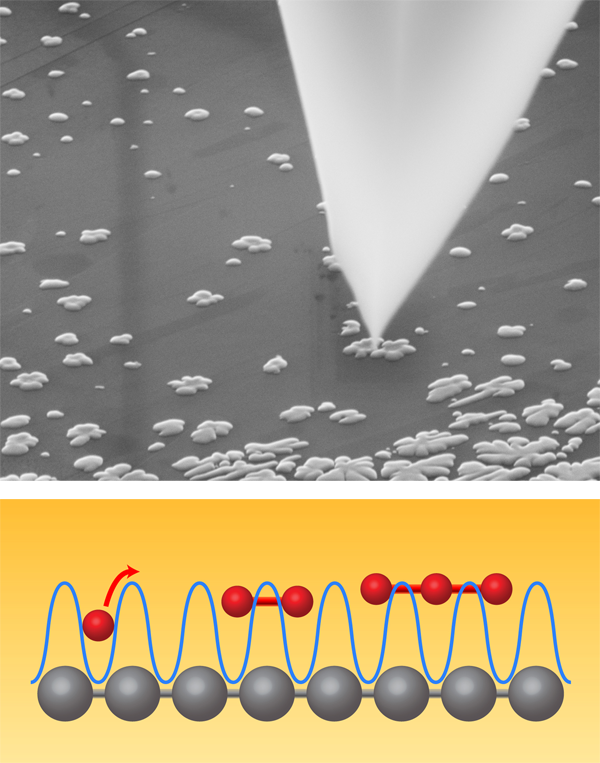Dragging Nanoparticles Reveals Extra-Low Friction
By pushing various nanoparticles along a flat graphite surface, researchers have verified the predicted breakdown of a standard law of friction. They showed that nanoscale objects with the right atomic structure can slide with extra-low friction, a theoretical prediction that has previously disagreed with experiments. The results, reported in Physical Review Letters, may help link the theory of atomic interactions with that of large scale friction forces and may also boost development of low friction materials for small devices.
If you slide a block across the floor, the floor’s roughness presents tiny peaks that obstruct the downward peaks from the block’s lower surface. In order to move, the block must “climb” over the floor peaks by rising up ever so slightly, which translates into lost energy, or friction. A similar process is expected to occur at the microscopic level when two surfaces contact each other. Here, the “roughness” is due to the atoms on the bottom surface that essentially obstruct the atoms on the top surface by presenting a potential energy barrier, or peak, they must climb over to move forward. If the two surfaces have the same atomic structure, then they can lock into each other periodically. In this case, the friction is proportional to the area.
However, if the two surfaces have different atomic spacings, then the atoms of the top surface will not be able to nestle as far down into the valleys, so they will experience less friction. Researchers have seen evidence for this effect, called super-lubricity, in a number of experiments (see 2 April 2004 Focus). However, no previous study has observed the predicted area-dependence. “If you increase the contact area, the mismatch between the surfaces becomes worse,” explains André Schirmeisen of the University of Giessen, Germany. The worse mismatch means that a wider object will rise even higher above the surface roughness, and so the friction force increases with area more slowly than in the macroscopic case. For large objects, friction is directly proportional to area—assuming that the weight of the object increases with area—but Schirmeisen and his colleagues have now measured the sub-linear scaling expected microscopically.
One of the reasons previous friction experiments have seen only linear scaling is that contamination provides mobile atoms or molecules that can fill in gaps between the surfaces, resulting in an effective match between the two atomic structures (see 19 September 2008 Focus). To avoid this, Schirmeisen and his collaborators grew their nanoscale “sliding blocks” on a graphite surface in an ultrahigh vacuum.
The nanoparticles were made of either amorphous antimony (which shouldn’t match the atomic spacing for any crystalline surface) or crystalline gold. By varying the growth time, the researchers produced nanoparticles with contact areas from 2000 to 200,000 square nanometers, as determined with an atomic force microscope (AFM). After imaging, the researchers selected a nanoparticle, pressed it with the ultrafine point (called the tip) of the AFM probe and then dragged it along the surface at a constant speed of 1 micrometer per second. The team determined the friction force from the bending of the AFM cantilever connected to the top of the tip.
For the amorphous antimony nanoparticles, the friction force increased as the square root of the area, which agreed with theoretical predictions [1]. The crystalline gold results were slightly more complicated by the fact that—for certain angular alignments—the gold atoms can partly fit into the valleys of the graphite surface. Because of this and other factors, the force-area relationship for gold depended on direction, but it was always sublinear.
The researchers also showed that their results could extend to single atoms. They converted the force-area relationship into a relationship between friction and the number of atoms. From this, they derived the “friction” for a single atom and found it was consistent with the surface “stickiness” that others have measured from studying the diffusion of single atoms on a graphite surface. Schirmeisen says that this connection between atomic dimensions and micrometer scales may eventually lead to a model of macroscopic friction—for sliding blocks or even colliding continents—based on atomic physics.
Martin Müser of Saarland University in Germany finds these results “exciting” because they imply that friction can be derived from simple geometric arguments, without introducing any complex atomic interactions (such as adhesion forces). Rob Carpick of the University of Pennsylvania is also impressed: The new work “demonstrates important new evidence to support the idea that ultralow-friction interfaces can be experimentally achieved.”
–Michael Schirber
Michael Schirber is a Corresponding Editor for Physics Magazine based in Lyon, France.
References
- M. H. Müser, L. Wenning, and M. O. Robbins, “Simple Microscopic Theory of Amontons’s Laws for Static Friction,” Phys. Rev. Lett. 86, 1295 (2001)





